03.11.
– 10.12.2003: Patagonia (Torsten)
translated by Renate
Adam

Before I start my report, I will have to tell you about Tierra del Fuego in a few sentences:
Judith and Carlos give us another warm welcome. The very first afternoon they take us to the “Club Nautico”. In spite of the predicting “jeers” of many friends they are standing there in the corner untouched just like we had left them behind: The red “Papagayo” and the yellow “Llamencito” – the two trusty companions of our journey.
At first a thick layer of dust conceals the original colours of the motorbikes but nevertheless we identify them as ours at once. For the next four days we screw and fix and replace various part, that we brought with us in a 15-kilo-case:
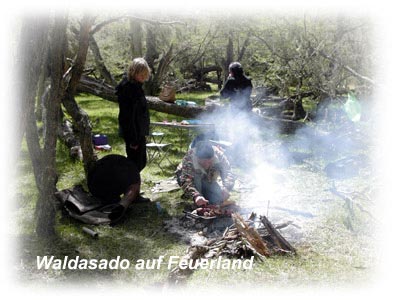
2 new holding devices for lamps, 2 mounting supports for luggage porters with 2 top-case like rear bags; air filter, oil filter, brake lining, spray for the chain, bowden wire for the clutches, 4 new pinions, mudguard (fender) extension, fenderbags (made by Touratech), strengthening plates for cases, folding garages for motorbikes (protecting cover), screws and other small spare parts.
And again Judith and Carlos prepare meals for us and we have to eat them “without mercy”, for example "pollo naranja" and black beans with molletes or “carne con hongos y crema”.
One Sunday we go out into the
country with Alberto. He shows us a feature of Tierra
del Fuego that we did not know yet, wild, original, romantic
– beautiful.
Of course there is an asado in the forest like there
ought to be.
After a break of nearly eight months including 9 days in Rio Grande / Tierra del Fuego time has come. We continue on our journey.


The first day has a smashing start, we are five minutes late and miss the ferry from the island Tierra del Fuego to the continent - to Patagonia. Unfortunately the tide is down now and we have to wait for three hours. The next ferry only leaves at 8:30 pm. So it is already after 9:00 pm when we can set out in Patagonia. It is the first time that I envy those backpackers and tourists travelling by bus, who can now be seated on the heated bus for two hours and need not worry about nightfall, outside temperatures of 4°centigrade, and the incessantly blowing wind.
Patagonia extends in Argentine
over the provinces “Santa Cruz” in the south,
“Chubut” and “Rio Negro”
in the north and the southern part of Chile; it extends over nearly 2000
km from 55 degree to 39 degree of southern latitude. In the west
fjords reach far into the Andes with their many lakes and glaciers and
with the highest peak Cerro Valentín, with an
altitude of 4058 m. The mountains keep
away the rain from the eastern part, that belongs to Argentine. Sloping
to the east that part is a distinct tableland.
For comparison: Buenos Aires is situated at almost the same degree of
latitude as Cape Town (South Africa) or Sydney (Australia) and another
1000 km north of Patagonia. Projected to the northern hemisphere it would
reach from Madrid to the south of Sweden.
You are able to experience all four seasons in one place
and that in the course of one day. The weather is unpredictable
and erratic. A sunny and cloudless morning like in spring
may be followed by an autumn storm at noon (where did
all those clouds come from so suddenly?). And that cools down the afternoon
with its showers of hail and small hail to 3° centigrade like in winter.
Later the wind stops – sudden calm – and sunshine until late
at night makes it a summer evening and you will enjoy
listening to the sound of the burning campfire.
The incessantly blowing wind makes the difference. It is often so windy that when I’m peeing (with the wind , of course) there are strong whirlwinds at the leeside of my body so that some “drops” even reach the visor of my helmet.
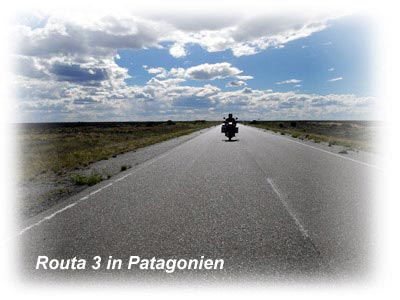
After having left Rio Gallegos (largest city in southern Argentine Patagonia) we set the cruising speed to 85 to 93 km/h, fix the magnetic needle of the compass to N and adjust the throttle control to more than three quarters power. We are riding in an inclined position of 5 – 10° portside (left). The helmets are tightly closed with visors shut and our clothes are well sealed against the wind. Long pants, several layers of t-shirts and sweaters are obligatory in our basic outfit. That is how we ride along the ”well frequented” Routa 3 northward. One day the first car that overtakes us comes after 238 km. (Days later when we take the way west in direction of the Andes we ride for two days without overtaking a car or being overtaken.)
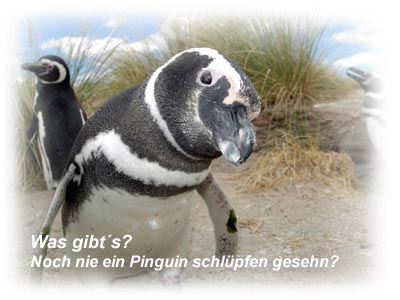
The third day we make an excursion of 300 km along a gravel road to visit the "Cuevas de los Manos", caves with prehistoric paintings of mainly hands. In an unexpectedly spectacular landscape of canyons a primitive race settled and left their “hands” more than 4000 years ago. The canyons are situated on the land of an estancia, 20x70 km large, the owner of which is quite nice and freely gives us information. But from the first moment I have a feeling as if not all was okay. When we start talking about the entrance fee to the canyons, I find my suspicion confirmed: He wants as much as 45 Pesos per person for a day visit – his motto may be that those, who have travelled so far, will pay any price! After some discussion we agree on half the price for half a day of sightseeing.

200 km north of Comodora Rivadavia we again leave the Routa 3 for a side-trip to the fishing village “Camarones”. In the nearby “Reserva Natural de Cabo dos Bahías” we are nearly the only visitors except for some guanacos, nandus and the about 40,000 Maghellan penguins. For hours we enjoy watching their droll behaviour. A narrow path has been laid out through the penguin colony, which two times leads over footbridges. Standing at the end of one of those bridges we watch how a young one – 3 to 5 days old – is fed. Only after several minutes have passed, we realize that below the bridge, directly beneath our feet, a small penguin is just being peeled out of the egg by its mum. Wow – what a thrilling event!
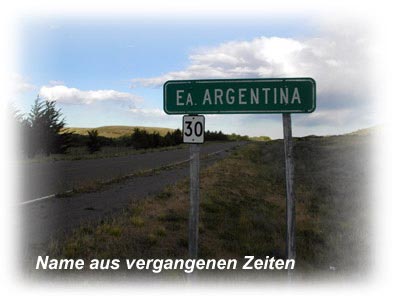
The next day
on our way back to Routa 3 we make a stop at the estancia “Argentina”,
though since the Falkland war it is called “Lochiel”.
From the road you can already see that sheep are kept here, as hundreds
of sheep are rounded up between the fences. At this moment I would like
to know more about sheep and wool.
The first thing I do is asking the foreman Hector Hernan Peña
if we might have a closer look at the estancia. He jokes a bit
and asks why we don’t just buy the estancia. But
from the beginning it has been clear that he would agree. To come to the
point, first we are invited to coffee
and apple cake just from the oven. Finally
we are allowed to build our tent
on a green meadow among swans and flamingos near the lake belonging to
the estancia and are later invited to
dinner.
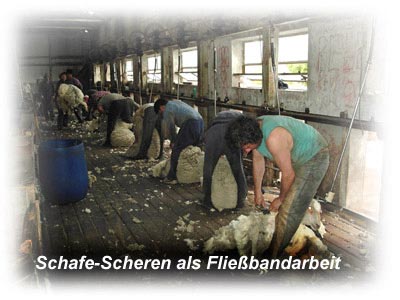
“Only” 147,000 hectares belong to the estancia with 47,000 sheep and about 23,000 young sheep. Shearing of the sheep takes about 4 – 5 weeks. A team of 23 workers comes to do the job, 10 who shear, assistants and the cook. One man shears more or less 130 sheep a day – like assembly-line work. The wool is pressed a quarter automatically in bales, that weigh between 200 and 250 kilos. In another place the animals are separated. Young ones to the left, females to be sheared to the right and the males off in the middle. The never ending “Bah, bah, bah!” fills the wind blown, dusty air around us, and again and again we hear the gauchos shouting. My photo equipment becomes dustier during that afternoon than after five days travelling through the dry Altiplano of Bolivia.
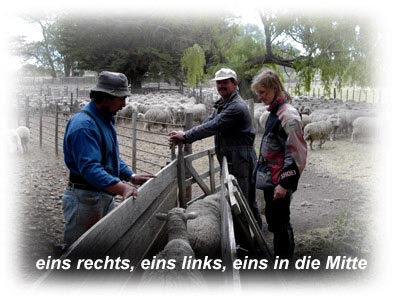
After his day’s work has been done (at about 7 pm) Hector only makes a short remark: “We eat at eight, not earlier, not later.” We follow his admonishing words and shortly before eight o`clock we stand waiting at the entrance of the “cocina”, the kitchen house. “¡Entra, entra!” – come in, sit down and eat. There is fresh lamb, roasted in the oven (what else?!?) The gloomy looking gauchos are sitting at the table silently only busy eating their meal. Each one takes his own sharp knife from his belt and cuts off huge ribs or other parts of the roast. The meal ends without talking a lot, a short “provecho” (have a nice meal) and they leave the room. At four o’clock the next morning their night will end, then they will ride out again, round up the last sheep, repair fences or shoot another baby guanaco to feed their dogs. We still have a few moments for a talk with Hector, his wife Teresa and their daughter Carolina, to get to know a little more about the estancia and about life on the South American continent which is the reason why we are travelling here.
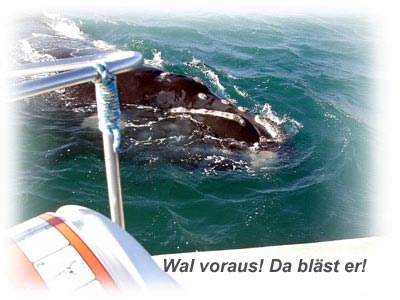
In the far north of Patagonia we experience two more highlights of our journey. We visit the peninsula Valdés, camp for 5 days near the small place Puerto Pirámides not far from the beach and even from the land we can see the Southern Right Whale jumping!
Of course we don’t miss the “Whale-watching tour”. Once we are so close to a whale that it touches the boat with its tail fin. But don’t be seized with panic it is such a light prod that we do not notice it, we can only hear it. There were about 8-10 whales in the bay off Puerto Pirámides. An impressing spectacle, and it has been worthwhile paying those 50 Pesos per person.
The following two days we
explore the rest of the peninsula.
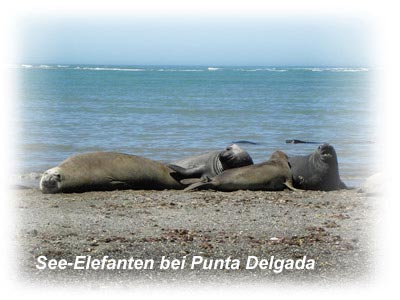
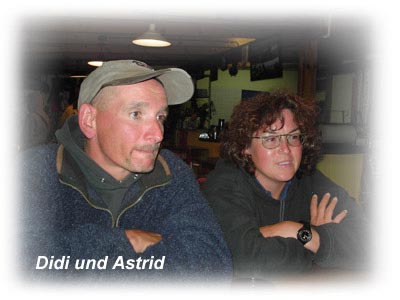
The second “highlight”
are two “locos alemanes”, that we meet at
a camp-site. We spend four amusing days with Astrid
and Didi. Fun begins when Didi just has to play water-ball
on the beach. Well, to please him. Like a young playful dog he jumps and
enjoys it when we throw the ball as far as possible out into the water
that is 12 degrees “warm”. Didi (41 years old, born in Brazil)
actually is a motor-biker, too. Eleven times he crossed
the Sahara by motor-bike, went by mountain-bike
to the Ivory Coast, hiked through
parts of the Amazon region and can hardly tell which of his bones has
not yet been broken. Nevertheless, he is a jolly (Lower
Bavarian) fellow and we have a lot of fun together.
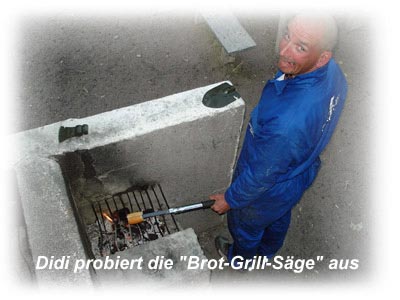
He makes this trip, though, in a Toyota Landcruiser, converted into a salvage tank. In Germany they take it for a mobile home.
Of course we prepare an asado one evening. While the meat is being grilled, a championship develops (Didi is the champion in every field, you know). How could I, the motor-biker, surpass him, the car-driver?
First I took our coal-shovel from my case which I could quickly convert into a “bread-grill-saw”. As a result he got out his 80cm-hacksaw, which he had already used to cut half the Bavarian Forest. I rummaged in my case and got out special working-leather-grill-gloves.
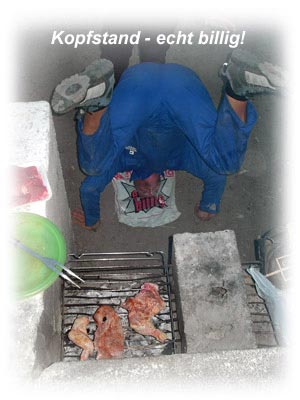
He disappeared in his car for a short moment, reappeared with his brand-new building-work-gloves and made a headstand right in front of the grill on an original plastic bag from a German supermarket. Finally I outdid the competition with our 35cm-grill-fork (from South Africa). There was some laughing and yelling, Didi had nothing to put against it.
Instead of this he used the grill-fork perfectly to fry the chicken parts on all sides crisp and brown, and he did that very well. Those who want to know more about Astrid and Didi can read about them under “kollegiale Menschen”.
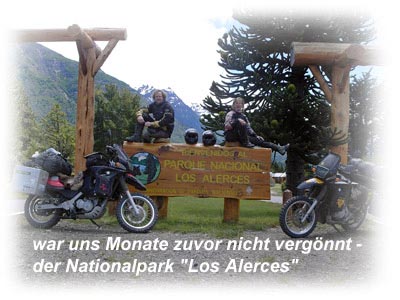
For the rest of our adventures in Patagonia we slowly move back to the Andes in the west. On our way we see an old nostalgic narrow-gauge railway, called “La Trochita”. It only runs once or twice a week between Esquel and El Maitén. Five steam engines are still running although they are already 80 years old and the carriages are still heated by very ancient stoves.
In the end after more than 8000 kilometres in the wind we have our last experience in Patagonia in the very place where we turned back a few months before because of the rain, in the Parque Nacional “Los Alerces”. There is a special kind of coniferous tree, the alerce, in this very large park which is a good place for hiking, too. The extremely slowly growing tree makes it only 1 cm of growth in 10 to 15 years. So the biggest alerce is estimated to be 3000 years old.
We are lucky, the normally erratic Patagonian weather lets us spend two wonderful days in the park.